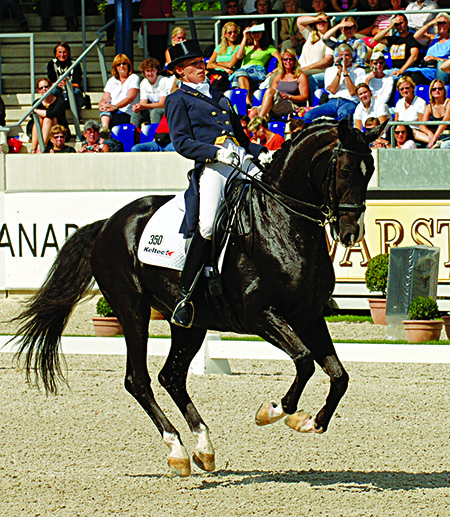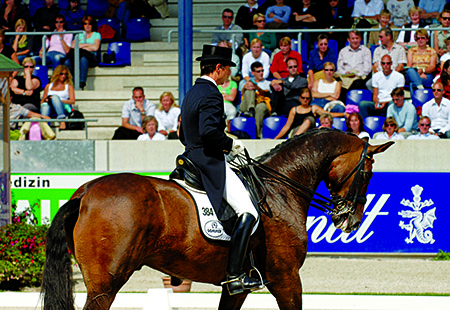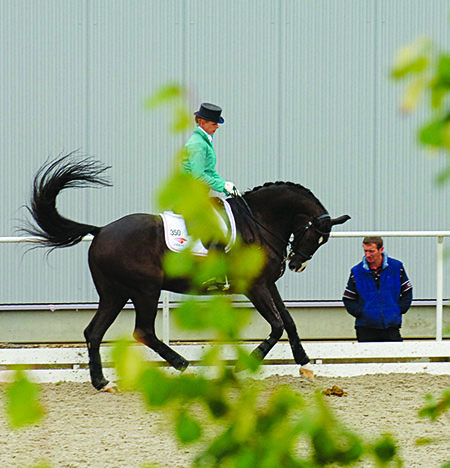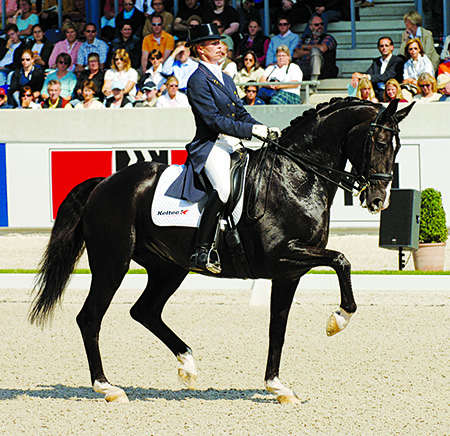In 2005 the dressage world was set alight with the publication of this article in the German magazine, St Georg….
The dressage sport is degenerating. Many horses are lost along the way. Those that make it into the arena often seem to be over-trained. Hardly anyone shows interest in the principles of the classical education. There are many discussions next to the warm-up arenas and on the internet. The judges however look away, they would rather concentrate on voting for the apparently happiest athlete. If nothing else works the vet has to fix it. A ST.GEORG- article…
Anky and Salinero at Aachen 2005…
The ship deviated from its course at some point. No-one knows exactly when. Neither the sailors nor the captain. Maybe they do not want to know. Their motto: Everything is under control on the sinking ship. Remind me, what was it again? Dressage-riding includes the gymnastical build up and thorough education of the horse, in order to fully develop its natural abilities, to increase its capability to perform well, to maintain its health and last but not least to achive a harmony between the horse and its rider. This, translated into english, is how it is printed on page 9 of the German guidlines for Riding and Driving II. And further it is implied that under no circumstances is the rider to mistake dressage-riding with teaching the horse random tricks and magic acts instead of sympathetically educating the horse in a correct manner. Can we call that which begins in the warming-up arena and is later gaining marks which are approaching the ideal, still harmony? Or is the scenario, repeated week after week, more of the picture of a fight of man against beast? Many spectators are disappointed by what they see when watching riders prepare for the important competitions. Is this the true face of top level dressage? Those who stand close enough to the warm-up arena will soon hear people wondering about how the training might look like at the riders homes, without the public watching them.
Weltall and Martin Schaudt – not a pretty picture…
No-one will doubt that the top-level sport needs individual training concepts. It is well known that all roads lead to Rome. Two riders and their trainers have been warned in Aachen in 2004, not officially of course – judge Christoph Hess spoke to the trainers: The way Isabell Werth and Anky van Grunsven prepared their horses for the competition received negative attention of the audience as well as the official steward. Martin Schaudt had received complaints the previous year. As most are aware, van Grunsven won the Olympics in Athens a few weeks later on Salinero, Isabell Werth can only maintain control of Satchmo in patches now and Schaudt’s Weltall completely quit cooperation with the rider during the freestyle in Athens, but later, during the indoor season, rose like phoenix from the ashes and gained world record points in the Grand Prix Special. Each of Weltall’s outings is followed with excitement. They speak of genius and insanity, the same applies to nearly every world class horse, apart from the diligent worker Gigolo. We thinking of a genius when we watch Weltall’s legs during the passage and piaffe, sticking precisely to the rythm like clockwork; insanity when he does not manage to complete a test without making fundamental errors – errors related to the very basics of a horse’s education, such as the rythm in all three basic gaits. This is a fate which Weltall shares with Satchmo. Although Satchmo sticks to the rythm, he is not obedient. Isabell Werth abandoned her plans to start at the German championships in Verden after her future prospect – who seemed to have been on his way up at that point – abandoned his share of their combined effort to finish the test whilst competing in Balve. And also Nadine Capellman’s future prospect Elvis, which many predict to have a great career ahead of him, quit his duties and bolted across the the warm-up arena, instead of of doing the piaffe – apparently, as claimed a few days after the incident, due to a trapped sciatic nerve.
Crime scene warm-up arena
There is hardly any competition without debate. The audience complains. Some protested against van Grunsven’s training methods in Las Vegas and increased the pressure on the steward until he eventually approached the Olympic medallist. For Mariette Withages, chairman of the dressage committee of the FEI, it was just a little side comment – well, she just rode Salinero very deep, this is how it is done nowadays. And as the judges only judge what they see during test, the horse and rider combination gained record marks in the freestyle to music and even a 10.0 for their choreography of the German judge Uwe Mechelm. Later, on the phone, questioned about the incident in the warm-up arena, Mechlem claimed not to know anything about it: Oh, did that really happen? It seems as if the judges sometimes resemble the three wise monkeys: blind, deaf and dumb. To open one’s mouth could become rather uncomfortable – after all the rather chummy dressage society meets weekly and it would be upsetting not to remain friends with everyone.
This is how it is done nowadays – maybe that is the sticking point. Observations at the warm-up arena during the World Championships of Young Dressage horses: Five and six year old horses, ridden by Dutch riders, are being prepared for their big outings. Seemingly the horses are biting into their own chests. The rider pulls the reins towards his abdomen whilst holding his hands extremely far apart, the head of the horse gets yanked from one side to the other. Then he stops. Repeated pulling, a quick kick with the spurs, the horse trots on. Not even three metres later he stops again: The rider moves his legs away from the horse‘s body, leans back with all his strength. Again the reins get pulled left and right. The horse’s nose is approaching the 45° angle behind the vertical, the neck is tightly rolled. The same moment the horse comes to a standstill, the rider‘s leg gains momentum. Again the spurs, again halting, again left and right on the reins.
Scenes like these are not rare. And of course the German riders are just as capable of riding their horses that tight and that deep. Only the methodical, the strict repeated biting into the chest, is not – yet? – the norm. The piaffe also gets carried out in this posture – shortly before entering the Young Dressage horse class, as shown by one of van Grunsven’s students.
The Dutch national trainer Sjef Janssen has been questioned many times relating his training methods. He repeatedly stressed in interviews that, what he calls long and low is beneficial for the horse, and that, in his opinion, the classical education harms the horses. His best argument is Bonfire, winner of the Olympics 2000, which is still fit as a youngster although he is 23 years old. And it is Bonfire, as can be seen on Anky van Grunsven‘s website, that Sjeff takes out of his stable every now and then to do a bit of piaffe. With an extremely deep head carriage, of course. It looks like the method which Nicole Uphoff and Isabell Werth brought to perfection, based on the training with Dr. Uwe Schulten-Baumer, the ill famed rollkur, discredited by ST.GEORG. But Janssen disagrees. He told The Horse Magazine of Australia that his method of training horses has nothing to do with this. In his opinion the rollkur results in problems with the horse not remaining in a steady contact.
Happy Athlete
The long haired Dutchman has always been an Enfant terrible; his fans point out that the rejection of his training methods might be a result of him being different from the ladies in pearl necklaces and the gentlemen with silk hankies lurking in their pockets.
You can only judge what is happening during the test, Withages explains to the ST.GEORG in an interview after the Olympic Games, in order to eliminate all prejudices against the warming-up methods. The stewards are responsible for the supervision: I rarely stand by the warm-up arena when I am judging. I feel I have no right to be there at that moment. She admits though that certain training methods are a case for the vet. Soon after publication ST.GEORG received an email from Sjef Janssen. He immediately took that sentence as a criticism of his training method. The debate about Anky’s methods – which also her star student Edward Gal uses successfully – does not interest her anymore, said the Olympic Gold medallist in an interview, published in the current issue of the Magazin Hors International distributed by the Dutch sports marketing agency BCM. After all, her students are successful. Bonfire was at the peak of his performance at the age of 17 and her horses are happy and healthy. They are said to live a blissful life and are neither being maltreated with spurs nor do they have blue tongues.
The voices that grew louder in Las Vegas have been commented on by Janssen in the Dutch magazine In de Strengen. His reply: Ignorance. At the same time he is defending the freestyle-inventor Joep Bartels, during whose Global Dressage Forum, Salinero was voted as the Happiest Athlete. The veterinary proof, that his training is not harmful, which is the opposite of what most vets claim, is meant to be made this year. The happy-athlete-rule has attracted the French Colonel Christian Carde to the discussion. He writes on the website www.allege-ideal.com how unfortunate he finds the newly formulated FEI article 401, with which the term Happy Athlete has been introduced to the regulations of the international federation of equestrian sport. He also commented on the long-and-low training pictures. His question: Why do the supporters of this training method seem to try to prevent publication of photos and discussion of something that they believe to be the ideal? If this is only about misunderstanding a training method, why not give a plausible explanation? Carde demands not only an open debate, but also the formation of a panel of experts made up of trainers, vets and ethologists (behaviourists). At the same time he questions if such a panel would show enough courage to let loose the Tsunami of objections that would follow.
One dressage expert shakes his head, one who passionately expresses his support for the classical way of riding: Olympic gold medallist Klaus Balkenhol, trainer of the American dressage team. Weary of what he often has to witness in the warm-up arena, he openly wonders if it makes sense to give marks for the warming-up prior to a test. A rather new approach, laughed at by many. But what, if such a marking scheme would have been in place at the Dutch Championships in Nijmegen, during which van Grunsven was openly dreaming about results in the region of the 90% mark? Indirectly such marking schemes exist, and the results are poor, as pictures from this event have circled around the world. A Swedish dressage rider had been given these pictures and published them on her website Dressage for the 3rd Millenium. All horses are seen going far behind the vertical, though this is an utter understatement. ST.GEORG also holds these pictures. A frantic witch-hunt has started in the Netherlands to find out who distributed these pictures.
Vet Dr. Gerd Heuschmann, who started a debate about current training practices by holding a talk on functional anatomy a few years ago, is speechless. The vet, who had been an education advisor with the German Federation of Equestrian Sport (FN) prior to becoming a veterinary surgeon, is pointing to the pamphlet, Animal Welfare in Equestrian Sport by the German Federal ministery for agriculture. Pain and harm, induced by excessive flexion is an offence against animal welfare. And of course there is the German law for the protection of animals, paragraph 3, 1b: It is forbidden to use methods on an animal, either in training or competition, which are associated with pain, suffering and harm and which can influence their potential for achievement.
Bulges on the neck
The dilemma: An international or at least EU-wide animal welfare law does not yet exist. And the FEI remains rather vague in their code of conduct regarding the horse’s welfare to which competitors subject themselves when entering the competitions: The welfare of the horse has to have priority, this for example also applies to the methods of training. Speaking of which – what is fairly common in Holland is the training with shoes which initially were used driving Hackneys, Tuigpaarden and Fresian horses. Wear and tear when using this method, with which you could even turn a cow into a piaffe and passage super-animal, is a certain outcome.
But also without the puppet-strings, the faulty riding has reached not only the top level sport. In veterinary surgeries Heuschmann gets confronted day in day out with the harmful changes in the horse’s body caused by riding in a constant, extreme over-bend. The complete so called upper tightness (cervical-, thoracis-, amd lumbar spine as far as ilio sacral joint) including the rump gets badly affected. Inflammation occurs, which might later lead to calcification. Real bulges are formed, sometimes even as big as a child’s fist. All of this is painful and can lead to permanent loss of use of the horse. Such clinical pictures have risen in numbers lately. Heuschmann counters the supporters of the thesis, who believe horses become more submissive if ridden with a pronounced over-bend, which apparently after all resembles a form of stretching, so far they have not yet looked further into the group of muscles which actually carry the rider’s weight. These are mainly the abdominal muscels instead of the long muscles in the back.
ST.GEORG expert Dr. Karl Bobel points to the lack of knowledge amongst the dressage riders, with regard to physiological consequences. Dressage is by now the most health-problematic sport because the horses do not get turned out. Out of fear of injuries the horse gets taken out of its stable for the training, after hours of standing still, and immediately gets subjected to constraints. Blobel reminds us that not only all muscles, ligaments and tendons but also the digestive system needs a certain amount of work load. This, when the majority of training methods aim at subordination rather that cooperation, usually falls by the wayside. And what if everything else is too late? When the ligament in the neck is inflamed, the vet surely can help. He simply takes those parts, that cause the nuisance, out. Apparently the horse can be used again one year later.
Dr. Blobel wrinkles up his nose: Clinical diagnostics in the cranial area of the spine are difficult, even experts come to completely different conclusions when interpreting radiographs. We also don’t know exactly to what extent anatomical adaptations really influence the horse’s performance. The vet’s ambitions are a further aspect which plays a major role: Every vet, every surgery is of course tempted to try new forms of therapies for all the new problems which keep surfacing. But in my point of view the majority of new therapies has not led to sucess. Blobel sticks to his conclusion: Dressage riders have to re-educate themselves, they have to allow their horses exercise without constraints, and then they will remain healthy. The riders have to inform themselves what happens in and around their horses during training. They have to get to know their horse’s training-psychology.
Heuschmann follows a second starting point: Back to the roots. It is the overload of the three to four year old horses, their industrial commercialisation, which opens the door to early wear and tear. Collection is attempted way too early. Only a horse, which has been worked long and low for long enough, has the chance to develop enough strength. The most sensitive measuring device is the improvement and retainment of the natural basic gaits. Many four and five year olds show an impaired footfall in the walk and trot.
Threat by email
Following emotional debates on the internet surrounding the pictures taken at the Dutch championships, the publisher of the website Dressage for the 3rd Millenium received an email from Sjef Janssen. He threatened to take legal action, as the personal rights of Anky van Grunsven had been violated. He further made his opinion known, that the web-publisher had no idea what she was talking about. His riding principles were good for the horse’s build-up of muscles. Publishing the warm-up pictures was dishonest and manipulative. Our horses love to work for us. She should furthermore watch the show-jumpers during their training – there are many similarities. Then he threatened to involve his lawyer. A lot of effort – considering Janssen does not get tired of advertising his method as gentle for the horse. Why then, if it fills the horses with joy, is it not allowed to publish pictures of it? Such emails were sent by Sjef Janssen a few times. The American Kyra Beth Houston recieved an electronic letter in November 2004. This time because of video recordings, which the American took in Aachen. She has an agreement with the Aachen-Laurensberger Rennverein (ALRV) since 2001. In the USA, South Africa, New Zealand, in short all dressage enthusiasts outside Europe, the videos are in fashion. They show tests from the view of the chief judge at C, including the marks given. The feedback is great, says Beth Houston: What does a 9 look like? People get their questions answered and they love it, especially during judging seminars. And of course it can be seen that, for example, a horse, which, during the initial halt, hardly stands still for one second, can still get the high marks. This had to be stopped. Kyra Beth was told, she is violating Anky van Grunsven‘s personal rights. She was not allowed to distribute any videos. The American took the matter to the ALRV, which did not react for a long while. Half a year later they sent a new contract with the request to show them a written consent of each filmed rider. However, the personal rights of top class athletes are restricted by law during public appearances. It is clear for media- lawyer Dr. Rainer Stelling: Although every person has to give their consent before a picture gets published, there is an exception: If somebody is, and has been for quite some time, of public interest, this consent is not needed. This also holds true for top-class athletes, especially if they are taking part in competitions which will increase the public interest in them. This does not apply to a commercial use. This has now reached the CHIO-organisers as well, who selected van Grunsven and Salinero to be their star guests during the weekend prior to the CHIO.
Show organiser Frank Kempermann replied when asked by ST.GEORG: It is written in the invitation, that we, as the organiser of the event, have all the film and video rights and we are allowed to sell them on. Riders have to accept this when entering the competition. Hence Kyra Beth Houston does not need to collect consents, and a filming ban for 2005 does not get mentioned anymore. As a matter of fact she has a two year long agreement. Recordings of the warm-up arena are not included, but every spectator certainly has the right to go there and have a look. And they should not allow anybody to take that right away from them.
Celebrity-Judging
The Problem of the cruel training methods in dressage is also the problem of judging. Where are the judges who are able, or would like to be able, to distinguish between a correctly schooled horse and a horse trained to show spectacular movements with the help of all sorts of dubious aids? Many judges have difficulties to see whether a horse swings properly from behind or only lifts its legs spectaularly in front, but with nothing to match behind, explains a Grand Prix judge to ST.GEORG. A new handbook, in which it is exactly explained what mark is to be given for which fulfilment of the required task, is supposed to help. Therefore judges, who maybe only judge a big competition once a year, only have to look at the list. Or alternatively at the large board, on which the marks for each separate movement are already shown during the test. It is ok for the audience, but when judges can see that their marks differ considerably from those of their colleagues, they will adapt their marks for the next movement, explains the previously mentioned Grand Prix judge to ST.GEORG. And that can hardly be the intention. At large premises, such as Aachen, the electric score boards are placed in such a way that they cannot be seen by the judges.
Judging dressage competitions is an thankfuless job: Only the winner is usually content. And as judgements contain a considerable amount of subjective arbitration, discussions about results after the competition can be endless. This has further increased with the introduction of the freestyle to music. Marks for components such as a nice choreography or suitable music make the final judgement necessarily even more subjective.
The organiser, who invites the judge, is happiest when the winner also is a celebrity, who he was able to attract to his event, and who he used to advertise that very event. The winner is more inclined to return the following year. Judges however are easily replaced, they simply do not get invited anymore if they make too many unpopular decisions. It does not matter how right or wrong those decisions were. Most judges, whether they openly admit to it or not, internalise this. There are three ways of judging: collective judging, separate judging and celebrity judging, so it is whispered – especially with the VIPs in the saddle, showing their spectacular performances, and the question of how they trained their horses? It is better not to ask.





This article highlights a number of points regarding the direction dressage has taken. This is a sport that I looked up to and aspired to as the riders had dignity, honour and respect for their very valuable (not monetary) horses as they are the true asset. I dare say it would not be as spectacular completing a piaffe, passage or any other manoeuvre out in the ring without a mount!
Dressage to me is Horse and Rider at ‘one’ with each other through kindness, mutual respect and lots of practice to achieve greatness. Not cruel training measures to win a prize or a purse or title. Where is the dignity, honour or valued achievement bought about by the horse and rider cooperation in that? Very sad. When is the world going to wake up and value kindness and dedicated hard work instead of celebrity or otherwise riders getting quick results using questionable methods at the expense of their horse(s)?